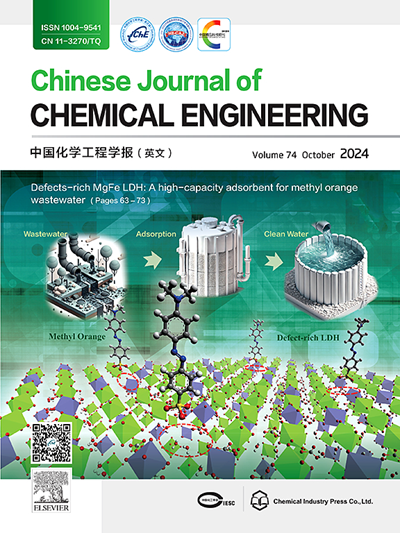Controllable prepared PDMS/SiO2/PVDF membrane for the separation of gaseous peppermint aromatic water
IF 3.7
3区 工程技术
Q2 ENGINEERING, CHEMICAL
引用次数: 0
Abstract
One of the main challenges in oil–water separation of traditional Chinese medicines (TCM) is to obtain essential oils from the aromatic water of TCM. In this study, silicon dioxide/polyvinylidene fluoride (SiO2/PVDF) membranes were prepared using nonsolvent induce phase separation. Then polydimethylsiloxane (PDMS) was coated to obtain PDMS/SiO2/PVDF membranes. Separated essential oils and water from aromatic water in the gaseous state by vapor permeation membrane separation technology. The relationship between membrane structure and membrane separation effect was investigated. Response surface methodology was used to develop a quadratic model for the separation factor, membrane permeation separation index and membrane preparation process. The optimal process parameters for the membrane separation were 12.31% (mass) concentration of PVDF solution, 9.6% (mass) of N,N-dimethylacetamide in the solidification bath, and 0.2 g hydrophobic nano-SiO2 incorporation, with a separation factor of 14.45, and a membrane flux of 1203.04 g·m−2·h−1. Compared with the PDMS/PVDF membranes, the separation factor and membrane flux were increased by 68.59% and 3.46%, respectively. Compared with the SiO2/PVDF membranes, the separation factor and membrane flux were increased by 478% and 79.33%, respectively. Effectively mitigated the limitations of traditional polymer membrane material performance affected by the “trade-off” effect. Attenuated total internal reflection-Fourier transform infrared spectroscopy, contact angle, scanning electron microscopy and energy dispersive spectroscopy were used to characterize the PDMS/SiO2/PVDF membranes, and gas chromatography was used to characterize the permeate. In addition, the contents of L-menthol, L-menthone, menthyl acetate and limonene in the permeate, conformed to the European Pharmacopoeia standards. This study provided an effective preparation strategy of a feasible hydrophobic powder polymer membrane for the separation of essential oils from gaseous peppermint aromatic water.

可控制备的PDMS/SiO2/PVDF膜用于气态薄荷芳香水的分离
从中药的芳香水中提取精油是中药油水分离的主要难点之一。本研究采用非溶剂诱导相分离法制备了二氧化硅/聚偏氟乙烯(SiO2/PVDF)膜。然后包覆聚二甲基硅氧烷(PDMS),得到PDMS/SiO2/PVDF膜。采用蒸汽渗透膜分离技术,从气态芳香水中分离出精油和水。研究了膜结构与膜分离效果的关系。采用响应面法建立了分离因子、膜渗透分离指数和膜制备工艺的二次模型。膜分离的最佳工艺参数为:PVDF溶液质量浓度12.31%,凝固液中N,N-二甲基乙酰胺质量浓度9.6%,加入0.2 g疏水纳米sio2,分离系数为14.45,膜通量为1203.04 g·m−2·h−1。与PDMS/PVDF膜相比,分离系数和膜通量分别提高了68.59%和3.46%。与SiO2/PVDF膜相比,分离系数和膜通量分别提高了478%和79.33%。有效缓解了传统高分子膜材料性能受“权衡”效应影响的局限性。采用衰减全内反射-傅里叶变换红外光谱、接触角、扫描电镜和能量色散光谱对PDMS/SiO2/PVDF膜进行了表征,并采用气相色谱法对其渗透进行了表征。此外,渗透液中l -薄荷醇、l -薄荷酮、乙酸薄荷酯和柠檬烯的含量均符合欧洲药典标准。本研究为分离气态薄荷芳香水中的精油提供了一种可行的疏水粉末聚合物膜的制备策略。
本文章由计算机程序翻译,如有差异,请以英文原文为准。
求助全文
约1分钟内获得全文
求助全文
来源期刊

Chinese Journal of Chemical Engineering
工程技术-工程:化工
CiteScore
6.60
自引率
5.30%
发文量
4309
审稿时长
31 days
期刊介绍:
The Chinese Journal of Chemical Engineering (Monthly, started in 1982) is the official journal of the Chemical Industry and Engineering Society of China and published by the Chemical Industry Press Co. Ltd. The aim of the journal is to develop the international exchange of scientific and technical information in the field of chemical engineering. It publishes original research papers that cover the major advancements and achievements in chemical engineering in China as well as some articles from overseas contributors.
The topics of journal include chemical engineering, chemical technology, biochemical engineering, energy and environmental engineering and other relevant fields. Papers are published on the basis of their relevance to theoretical research, practical application or potential uses in the industry as Research Papers, Communications, Reviews and Perspectives. Prominent domestic and overseas chemical experts and scholars have been invited to form an International Advisory Board and the Editorial Committee. It enjoys recognition among Chinese academia and industry as a reliable source of information of what is going on in chemical engineering research, both domestic and abroad.
 求助内容:
求助内容: 应助结果提醒方式:
应助结果提醒方式:


